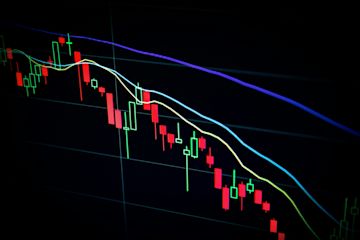
The myth of starting early: Why it’s never too late to start investing
Are your finances doomed if you don’t start setting money aside early? We explain why investing early is more difficult than it seems, and what you can do to grow your money at any age or stage.
11 min read
The following statements do not constitute investment advice or any other advice on financial services, financial instruments, financial products or digital assets. They are intended to provide general information. The following statements do not constitute an offer to conclude a contract for the purchase or sale of financial instruments and financial products or an invitation to submit such an offer and to buy or sell any particular digital asset.Stocks and ETFs are subject to high fluctuations in value. A decline in value or a complete loss are possible at any time. The loss of access to data and passwords can also lead to a complete loss.
Many of us have likely had similar experiences when it comes to investment advice. Whether it’s your entrepreneur uncle or your FinTok financial advisor, we often hear some arrangement of the same chorus: When it comes to investment, you need to start early. What these advisors don’t tell you is that there are some serious roadblocks to setting aside money — particularly when you’re young. Between low-paying entry-level jobs, poor financial education, and socioeconomic barriers, most folks entering the workforce are just trying to get by. And then, when they’re finally ready to start investing the money they’ve set aside after years of hard work, they’re told that it’s actually too late. Here’s the real truth: It’s never too late to start growing your money. And while time does matter when it comes to investing, it doesn’t need to matter in the way you might think. You may be surprised at the impact just a few years can have on your savings.In this article, we’ll explore why it’s so challenging to start investing early, despite what you’ve heard. Then, we’ll discuss how to think about growing your money when you are ready — no matter what stage in life you’re at.When it comes to long-term growth of your money, time in the market does matter. If you’re able to set aside even a small amount of savings each year, it can add up to a significant sum. But before you sacrifice your morning coffee on the altar of ETFs, it’s worth zooming out a bit. There are some important real-world caveats to the idea that everyone is equally positioned to open a brokerage account at the ripe old age of 21. Let’s take a look. According to USA Today, 65% of Gen Zers and 74% of millennials in the US report that they are starting further behind financially than previous generations. The 2008 financial crisis and its aftermath had disastrous effects on the economy, job market, and salary levels of millennials entering the professional world. Then, the 2020 COVID pandemic caused record job losses — with young workers hit the hardest. Now, with skyrocketing housing prices and inflation, life for younger people is getting more expensive — so much so that many are taking on second jobs to make ends meet. With so much volatility, it’s no wonder that young people don’t have the extra cash to set aside for retirement. Investing is many things, but intuitive is not one of them. Knowing when, where, and how to set money aside in any kind of product where it can grow usually requires training and education that many of us don’t have. According to CNBC, 34% of millennials in the US said they didn’t invest because they didn’t know how. Similarly, a study on millennials in Europe found that one third claimed they didn’t invest because they lacked the knowledge. The truth is, investment advice is often passed down in wealthy families, keeping the global wealth gap securely intact. Sadly, we don’t live in a world of equal opportunity — even, and perhaps especially, when it comes to finances. According to a 2022 survey by N26, women invest 29% less than their male counterparts. There are all kinds of contributing factors to this, including the still-staggering gender wage gap and the effects that childbearing and caretaking have on women’s careers. But it starts much earlier than that, too — a recent survey found that parents typically teach young boys to build wealth while girls are taught to save. That’s just the tip of the iceberg. The racial wealth gap continues to be prevalent across Europe, especially for immigrants or refugees. Many first-generation immigrants aren’t able to get much financial help from their families, or they might even be financially supporting family members themselves. For LGBTQ folks, continued discrimination across Europe means not only a wealth gap, but also a larger unhoused population and even wage discrimination, making investing more difficult than it might be for their straight or cis counterparts. Our brains don’t fully develop until we’re 25 years old. Specifically, the prefrontal cortex — the area of your brain responsible for executive function — is the last to develop. This means that future-based thinking, impulse control, and planning are more difficult in our early 20s, so we’re hard wired to live in the moment and not think about things that aren’t right in front of us like, say, our retirement. That’s not to say that young people don’t think about the future — we’re all driven by hopes, dreams, and goals. But given all the setbacks Millennials and Gen Zs have faced, plus the impending threats of climate change, some feel failed by their politicians, and have turned cynical about what’s to come in the next decades. And if you’re not feeling hopeful about the future, it may feel like a stretch to invest in it. As you can see, there are some very valid reasons why young people don’t start setting money aside early. But why all this talk about getting started as early as possible? Can you really catch up if you start later? Let’s take a look. Before we tackle the issue of time, we should clarify two different methods of how people have historically grown their money: investments and savings products. Investments are financial instruments that you purchase with the hope that they will grow in value. And investment can refer to anything designed to produce future income. These include stocks, bonds, real estate, private equity, precious metals, and many others. While the hope is that you gain money on investments, they carry a higher risk of decreasing in value (or even falling to zero).In contrast, savings products are accounts at a bank or financial institution where you can deposit your money and receive some interest in return. While the interest rates may fluctuate and your returns may not be as high as what you might expect from an investment, you generally don’t risk losing any of the principal balance you deposit. Time can work to your advantage with both investments and savings products. This is due to long-established historic trends (in the case of stocks and bonds) and the power of compound interest (in the case of both). You may have heard that “timing” matters when choosing to buy or sell an investment. The common refrain is to “buy low, sell high” — in other words, buy a stock (or any other investment) when the price is low, and sell it when the price is high.But what can matter even more than timing is time — as in, the duration of time you stay invested. Nobody can predict with certainty when a particular investment will spike or dip in value, but even if you pick the worst possible day of the year to invest, there’s a chance that your investment will gradually increase in value if you give it enough time.Why? Because while the market does have ups and downs, longer time frames are associated with more positive returns. The past doesn’t predict the future, of course. Still, every historical dip in the S&P 500 (an index that tracks the stock performance of 500 of the largest publicly traded companies in the United States) has been followed by a period of recovery and growth. These cycles may take a few years — in some cases, even a decade or more — to play out, but a longer-term outlook could help you ride out the down years long enough to experience the next positive peak. But again, historical trends don’t necessarily predict anything in the future, and every investment comes with a high level of risk and uncertainty.Longer investment timelines also help you benefit from something called compound interest.If you assume that there’s a positive annual rate of return on your investment or money in a savings product over time, you could also benefit from a phenomenon known as compounding. In simple terms, compound interest means that the earnings from your investment or savings are reinvested so that they keep earning for you. Compound interest is like a kind of acceleration effect, allowing your money to grow faster.With a savings product like an easy-access savings account, compounding in terms of interest is pretty straightforward — your interest on your deposit is reinvested, and you earn interest on your interest. Investments like stocks can earn money in two main ways. First, there’s the value of the stock going up, which is called capital gains. Or, some stocks pay dividends, which is an amount paid by a company to its shareholders, usually when the company is profitable. If you reinvest the dividends to buy more stocks, they might also grow in value, i.e. the earnings could compound over time.Compounding is most powerful when you give it as many years as possible to work. But even in a relatively short time period, it can have really powerful results. Here’s how.We can use a principle called the “Rule of 72” to illustrate this. This quick formula is a very rough approximation that estimates how many years may be required to double the money you invest, if you assume an average annual rate of return. All you have to do is divide the number 72 by a given annual interest rate. To illustrate, let’s use an interest rate of 6%, which is on the low side of the average returns of the MSCI Europe over the last 5-, 10-, and 20-year periods. Then, we can figure out how many years it will take to double your initial balance. For example, if you invest €10,000 and expect an average annual growth rate of 6%, you can expect your €10,000 to turn into €20,000 in about 12 years (72/6 = 12). If you’re investing in a savings product like a passbook, savings account, or term deposit account, you’ll know roughly how much you’ll get at the end of your deposit term when you sign the contract with your bank. And though the rates are lower, there’s significantly less risk. Let’s assume an annual return of 3%. In the same timeframe of 12 years, your money will grow to just over €14,000. However, note that unlike an investment, you won’t necessarily be able to withdraw the money at any time without paying a fee. 12 years may seem like a long time from now. But even if you’re already in your 30s or 40s, it will still come long before your retirement. So, it really isn’t ever too late to start. Yes, time matters, but time is on your side for a lot longer than you may think.
Putting money aside can be a real challenge when you’re young, whether it’s for old age or a large purchase down the line. After all, there’s no shortage of roadblocks — especially systemic ones that are affecting whole generations of people.But whenever you do have some money set aside and want to grow that money, the time to get started is now. Thanks to the benefits of compound interest, you can grow your money with a risk tolerance that suits your needs best.
Many of us have likely had similar experiences when it comes to investment advice. Whether it’s your entrepreneur uncle or your FinTok financial advisor, we often hear some arrangement of the same chorus: When it comes to investment, you need to start early. What these advisors don’t tell you is that there are some serious roadblocks to setting aside money — particularly when you’re young. Between low-paying entry-level jobs, poor financial education, and socioeconomic barriers, most folks entering the workforce are just trying to get by. And then, when they’re finally ready to start investing the money they’ve set aside after years of hard work, they’re told that it’s actually too late. Here’s the real truth: It’s never too late to start growing your money. And while time does matter when it comes to investing, it doesn’t need to matter in the way you might think. You may be surprised at the impact just a few years can have on your savings.In this article, we’ll explore why it’s so challenging to start investing early, despite what you’ve heard. Then, we’ll discuss how to think about growing your money when you are ready — no matter what stage in life you’re at.
Why it’s so hard to start investing early
Most young folks don’t have a lot of cash to spare
Many of us lack the education and guidance we need
Socioeconomic factors play an important role
Young people aren’t programed to think about the future — and if they do, they may not like what they see
Does time really matter when growing your money?
Investments and savings products: What’s the difference?
Timing vs. time in the market
What is compounding and why does it matter?
Compounding and the Rule of 72
So, how early should you start saving and investing?
Invest from anywhere with N26
With N26, making your money work for you has never been easier. Smart, intuitive tools let you invest your money your way — whether you want to start trading, automate your investments, buy stocks, or get into ETFs. And there’s no paperwork — just full transparency and security.
Plus, with N26 Spaces subaccounts, you can easily set aside funds for your investments. Ready for the stock market? Trade, invest, and manage your money with confidence.
Find similar stories
BY N26Love your bank
Related Post
These might also interest youINVESTMarket correction, explained: What it is and what triggers itA decline in prices isn’t necessarily a sign of a full-blown market crisis. Learn what a market correction is, what causes it, and how to spot the difference between a correction and a crash.
6 min read
INVESTWhat is earnings per share? How to calculate EPSGet familiar with the basics of earnings per share (EPS) and what this profitability metric means for investors.
5 min read
INVESTWhat is dividend investing? Here’s what you need to knowDividends are a piece of a company’s profit, and some investors focus their portfolios around dividend-paying stocks. Learn about dividend investing, from key metrics to risk management.
5 min read


